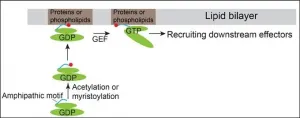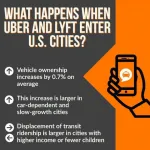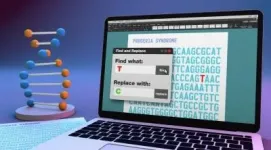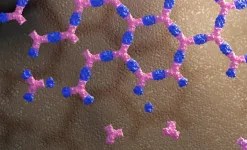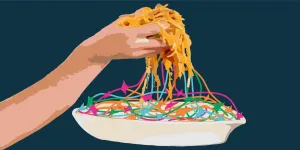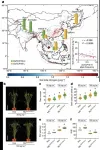Wait for me: Cell biologists decipher signal that ensures no chromosome is left behind
Researchers use novel probe to witness how a 'matchmaker' molecule puts the brake on cell division until components are ready to be split
2021-01-06
(Press-News.org) Starting as a single cell, organisms undergo millions of generations of divisions to ultimately generate the bones, heart, brain and other components that make up a living being. The mainspring within this intricate process is the transfer of DNA through each subsequent cell split within discrete packets called chromosomes.
It's critical that all chromosomes are duplicated and precisely distributed through every generation of cell division. If the inherited chromosome components are altered, even slightly, birth defects and certain cancers can result.
A new study published in the journal Science by postdoctoral scholar Pablo Lara-Gonzalez, Division of Biological Sciences Professor Arshad Desai and their colleagues addresses the mystery of how chromosomes are inherited correctly every time a cell divides. Using a novel probe that monitors a key aspect of this process, Lara-Gonzalez and Desai have detailed the mechanics behind a "wait" signal that ensures that cell division isn't prematurely set in motion.
The researchers concentrated their investigations on a pathway in the cell called the "spindle checkpoint," which is a type of quality control mechanism that ensures accurate chromosome inheritance during cell division. The spindle checkpoint pathway is activated at a site on the chromosome called the kinetochore, a mechanical interface where protein fibers are coupled to pull chromosomes apart.
"When kinetochores are not attached to these protein fibers, they send out a 'wait' signal that halts the cell in mitosis (cell division), thereby giving time for attachments to be formed," said Desai, a professor in the Section of Cell and Developmental Biology (Biological Sciences) and the Department of Cellular and Molecular Medicine (School of Medicine). "In this way, the cell makes sure all chromosomes are attached properly and ready to be pulled apart before the cell divides, thereby leaving no chromosome behind."
In the Science paper, the researchers describe how the wait checkpoint signal is specifically generated at kinetochores of unattached chromosomes. Serendipitously, they developed a fluorescent probe that enabled them to watch for the first time the key molecular event in wait signal generation at kinetochores in living cells.
"This work identified a key 'matchmaker' molecule that brings together two constituents of the wait signal that do not like to associate with each other on their own," said Lara-Gonzalez. "These findings help explain why the 'wait' checkpoint signal is selectively generated at kinetochores and not elsewhere in the cell."
The findings offer a framework for ways in which the accuracy of chromosome inheritance can be lowered in certain states of disease, such as cancer, the researchers said.
INFORMATION:
Coauthors of the paper are: Pablo Lara-Gonzalez, Taekyung Kim, Karen Oegema, Kevin Corbett and Arshad Desai.
Funding for the research was provided by the National Institutes of Health (R01GM074215, R01GM104141); Ludwig Institute for Cancer Research; S10 OD021724 (UC San Diego mass spectrometry); and the National Research Foundation of Korea (2020R1C1C1008696).
ELSE PRESS RELEASES FROM THIS DATE:
2021-01-06
Irvine, Calif., Jan. 6, 2021-- In the United States, Black, Latino and low-income communities have historically lacked nearby access to pharmacy services. To provide the first record of these "pharmacy deserts" in Los Angeles County, a University of California, Irvine study identified communities where the nearest pharmacy was at least one mile away.
Unlike previous studies, this one describes pharmacy deserts in terms of social determinants of health - such as owning a vehicle, crime rates and poverty - to determine which communities have the greatest need for pharmacy access. Published in the Journal of Racial and Ethnic Health Disparities, ...
2021-01-06
The small GTPases of the ADP-ribosylation factor (Arf) family are key initiators of various physiological processes including secretion, endocytosis, phagocytosis and signal transduction. Arf family proteins function to mediate recruitment of cytosolic effectors to specific subcellular compartments. This process facilitates Arf effectors to perform cargo recognition, lipid modification or other cellular functions. Blocking the activities of Arf family proteins inhibits secretion of important molecules from the cell and also inhibits cellular uptake of nutrients. Defects in Arfs or their regulatory proteins are related to various inherited diseases, including X-linked intellectual disability (XLID), Joubert syndrome, Bardet-Biedl syndrome and cilia dysfunction. Thus, studying molecular ...
2021-01-06
When ridesourcing companies Uber and Lyft show up in urban areas, vehicle registrations per capita increase by 0.7% on average, increasing even more in car-dependent cities. Researchers reporting in the journal iScience on January 6 made this discovery by analyzing data from major US cities between 2011 to 2017, comparing trends in cities where Uber and Lyft entered with those where they didn't. They also found that Uber and Lyft displace transit more in cities with higher income and fewer children.
"I would have expected people to own fewer vehicles once they gain access to this alternative transportation mode," says Jeremy Michalek, a professor of engineering and public policy at Carnegie Mellon University and co-author ...
2021-01-06
Researchers have successfully used a DNA-editing technique to extend the lifespan of mice with the genetic variation associated with progeria, a rare genetic disease that causes extreme premature aging in children and can significantly shorten their life expectancy. The study was published in the journal Nature, and was a collaboration between the National Human Genome Research Institute (NHGRI), part of the National Institutes of Health; Broad Institute of Harvard and MIT, Boston; and the Vanderbilt University Medical Center, Nashville, Tennessee.?
DNA is made up of four chemical bases -- A, C, G and T. Progeria, which is also known as Hutchinson-Gilford ...
2021-01-06
A new class of protein material that interacts with living cells without being absorbed by them can influence cell signaling, a new study shows. The material does this by binding and sequestering cell surface receptors.
The discovery could have far-reaching implications for stem cell research and enable the development of new materials designed to modulate the behavior of living systems.
The research, reported in the January 6 edition of Nature, was led by the Baker lab at the University of Washington School of Medicine and the Derivery lab at the Medical Research Council Laboratory of Molecular Biology in Cambridge, U.K. Their paper is titled, Design of Biologically Active Binary Protein 2D Materials.
Cells ...
2021-01-06
The westerlies--or westerly winds--play an important role in weather and climate both locally and on a global scale, by influencing precipitation patterns, impacting ocean circulation and steering tropical cyclones. So, finding a way to assess how they will change as the climate warms is crucial.
Typically, the westerlies blow from west to east across the planet's middle latitudes. But scientists have noticed that over the last several decades, these winds are changing, migrating poleward. Research suggests this is because of climate change. But, scientists have been debating whether the poleward movement of ...
2021-01-06
What The Study Did: The findings of this survey study suggest that simply providing maps with COVID-19 case information wasn't necessarily associated with improved public knowledge, risk perception or reported intent to adhere to health guidelines.
Authors: Angela Fagerlin, Ph.D., of the University of Utah in Salt Lake City, is the corresponding author.
To access the embargoed study: Visit our For The Media website at this link https://media.jamanetwork.com/
(doi:10.1001/jamanetworkopen.2020.33538)
Editor's Note: The article includes conflict of interest disclosures. Please see the article for additional ...
2021-01-06
What The Study Did: Changes in out-of-hospital cardiac arrests and fatalities in the Detroit area during the COVID-19 pandemic are compared with year-earlier events for the same period in this observational study.
Authors: Adrienne V. Nickles, M.P.H., of the Michigan Department of Health and Human Services in Lansing, is the corresponding author.
To access the embargoed study: Visit our For The Media website at this link https://media.jamanetwork.com/
(doi:10.1001/jamanetworkopen.2020.32331)
Editor's Note: The article includes conflict of interest disclosures. Please see the article for additional information, including other authors, author contributions and affiliations, conflict of interest and financial disclosures, and funding and support.
INFORMATION:
Media ...
2021-01-06
Writing, driving a screw or throwing darts are only some of the activities that demand a high level of skill. How the brain masters such exquisite movements has now been described in the journal "Nature" by a team of researchers at the University of Basel and the Friedrich Miescher Institute for Biomedical Research. A map of brainstem circuits reveals which neurons control the fine motor skills of the arm and hand.
Picking up a pen and writing our name or reaching for a fork to eat spaghetti with tomato sauce are things we take for granted. However, holding a pen properly or bringing spaghetti to the mouth without making a mess requires precise ...
2021-01-06
Chinese scientists from the Institute of Genetics and Developmental Biology of the Chinese Academy of Sciences (CAS) have found a gene that plays an important role in helping rice adapt to low soil nitrogen.
Nitrogen fertilizer application is a strategic challenge for sustainable agriculture: On the one hand, it plays an indispensable role in increasing crop yields, thus ensuring global food security. On the other hand, it creates a severe threat to ecosystems. For this reason, breeding new crop varieties with high nitrogen use efficiency (NUE) is a high priority for both agricultural production and environmental protection.
Using a diversified rice population derived from different ecogeographical regions, the scientists carefully evaluated how various agronomic traits responded to ...
LAST 30 PRESS RELEASES:
[Press-News.org] Wait for me: Cell biologists decipher signal that ensures no chromosome is left behind
Researchers use novel probe to witness how a 'matchmaker' molecule puts the brake on cell division until components are ready to be split
